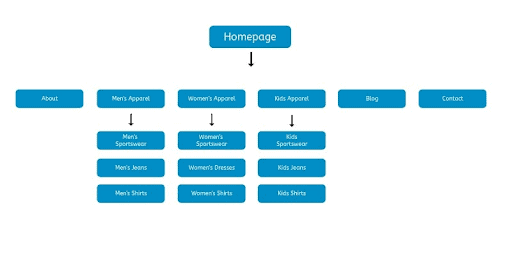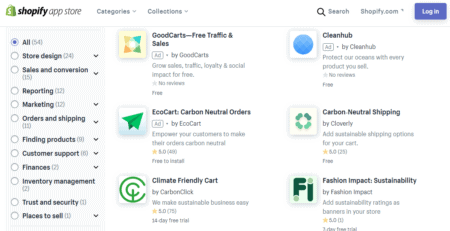Superpower your store’s Shopify SEO strategy with these handy tips, and target shoppers that are ready to buy.
It’s a simple equation: more traffic means more sales.
The hard part is getting enough traffic in the first place, and this is where Shopify SEO comes into play. Optimizing your site helps improve your search engine ranking and leads to more visitors. We’re not talking just any visitors here — we’re talking visitors who are specifically looking for what you’re selling. Read on or contact us for Shopify SEO help.
Shopify SEO Tips To Get More Customers
Here are some top SEO tips from your friends at GoodCarts to help your Shopify ecommerce store rank well.
1. Create a Site Hierarchy
Structuring your store not only makes it easier for customers to navigate, but it also makes it easier for Google to crawl each page and determine which ones are the most important.
Create categories and subcategories that link back and forth. This will indicate to Google which pages should take priority and give context to each subcategory. Think about it like a map of your store that guides customers to the products they want.

2. Use Data-Driven Keyword Research
Conducting and implementing keyword research will optimize your pages for the search terms customers are actually using. This attracts ready-to-buy shoppers and tells Google what your store is about.
You don’t have to be a Shopify SEO expert to nail keyword research. Start by writing down a list of relevant keywords for each product and use the following tactics to add more:
- Check out the “People Also Search For” and “People Also Asked” boxes on Google
- Explore Google’s autofill suggestions
- Conduct competitor research to identify the keywords they are using
Finally, run your extended list of keywords through a keyword research tool to identify which ones perform best and have a high number of searches with low competition. A Shopify-focused tools like SearchPie or Smart SEO are good places to start.
3. Optimize Metadata
Once you have an assortment of keywords to hand, you can start to sprinkle them strategically throughout your store. Elements to focus on include your page meta descriptions, title tags, and URLs.
When you optimize your metadata and incorporate keywords, Google is quickly able to see what each page is about and determine whether it’s relevant to searchers.
4. Add Alt Text to Images
Shopify stores are very visual. Product images are not only engaging and an important part of the buying journey — they offer a key asset for optimization, too. Add alt text and descriptions that incorporate your researched keywords into your images to boost their ranking.
Alternatively, you can use a Shopify SEO app like Alt Text that helps you populate your images with relevant, well-searched keywords.
5. Start Blogging
It might seem daunting, but blogging creates more opportunities for customers to find you, as well as increasing your ranking potential. The more pages you have, the more chance you have of showing up in searches.
Target shoppers that aren’t quite ready to buy yet and nurture them towards the sale through valuable and engaging content.
Blogging and content marketing on Shopify also generate backlink (links to your website from others) opportunities. The more backlinks you have, the better, since these are one of Google’s top three ranking factors.
6. Incorporate Video and Engaging Media
Create dynamic and engaging product pages with video, 360-degree photos, and customer reviews. These captivating assets boost the amount of time customers spend on site — but make sure your media is relevant. Cross-publishing your video content on YouTube can also give you an SEO boost.
The more engaging your product pages are, the more relevant Google is going to deem them. As a result, the search engine will push your store higher up the results.
7. Optimize Site Speed
79% of shoppers who experience slow loading speeds won’t return to a site to buy again. More surprisingly, 47% of online shoppers expect a page to load in two seconds or less. That doesn’t give you a lot of time to impress.
If your store is slow, people aren’t going to stick around. This will indicate to Google that your site isn’t relevant to the search terms used and will lead to it being bumped down the search results.
Increase site speed by choosing a fast Shopify theme, compressing images (you can use a Shopify SEO plugin like TinyIMG SEO Image Optimizer), and only installing the apps you need.
8. Improve User Experience
While it’s tempting to cater solely to Google, your customers still come first. Sites with a lower bounce rate perform better in search engines, so improving the experience customers have with your store will increase the amount of time they spend on your site.
Keep shoppers inspired with exit-intent popups and offers, dynamic product recommendations, and perks like fast and free shipping.
9. Optimize Product Pages and Descriptions
Incorporate relevant keywords throughout your product pages, including well-thought-out descriptions and product titles and tags. Again, this will give your store context and make it easier for buy-ready shoppers to find.
It’s a good idea to incorporate customer reviews to increase the number of keywords on each page too. Integrating reviews in this way will help improve your search engine ranking.
10. Optimize for Mobile
Predictions show that mobile commerce will make up 44% of all ecommerce by 2024. Shopify itself reported over a Black Friday weekend, that 69% of sales were on mobile. As shoppers increasingly rely on their phones, it’s up to you to ensure your store is mobile-ready. You can do this by:
- Choosing a mobile-ready Shopify theme
- Simplifying your design and removing any unnecessary distractions
- Making call-to-action buttons large and eye-catching
- Creating a smooth mobile checkout experience
In your Shopify Analytics, you can quickly see what percentage of your store visitors are mobile versus desktop today under “Online store sessions by device type.”
Give Your Store Context Through Keywords
SEO is crucial for attracting organic traffic to your store and reaching a wider range of shoppers. Not only does it make it easier for customers to find what they’re looking for — it provides Google with context and the relevant keywords they need to position your store well in search results.
Follow the tips we’ve provided to optimize your Shopify store, and enjoy a surge in visitors. You may also contact us for Shopify SEO help and we’ll connect you with the help you need.
And if you want some more, app-based help, check out this list of the best Shopify SEO apps and the GoodCarts free traffic ecommerce app powered by post-purchase cross-promotion.
GoodCarts is committed to helping our member stores gain new customers every ethical way that works. Why? Our free Shopify app is an ecommerce engine for free traffic that’s powered by post-checkout traffic from customers who care about impact and awesome products. When you win, we all win! Let’s grow together.











